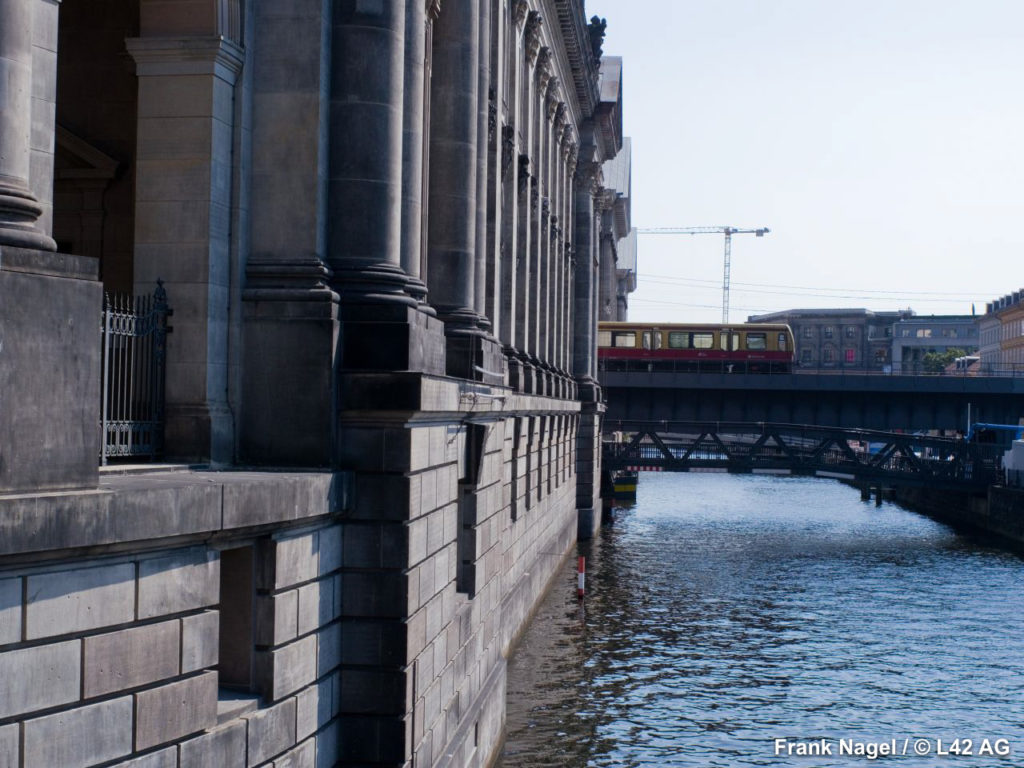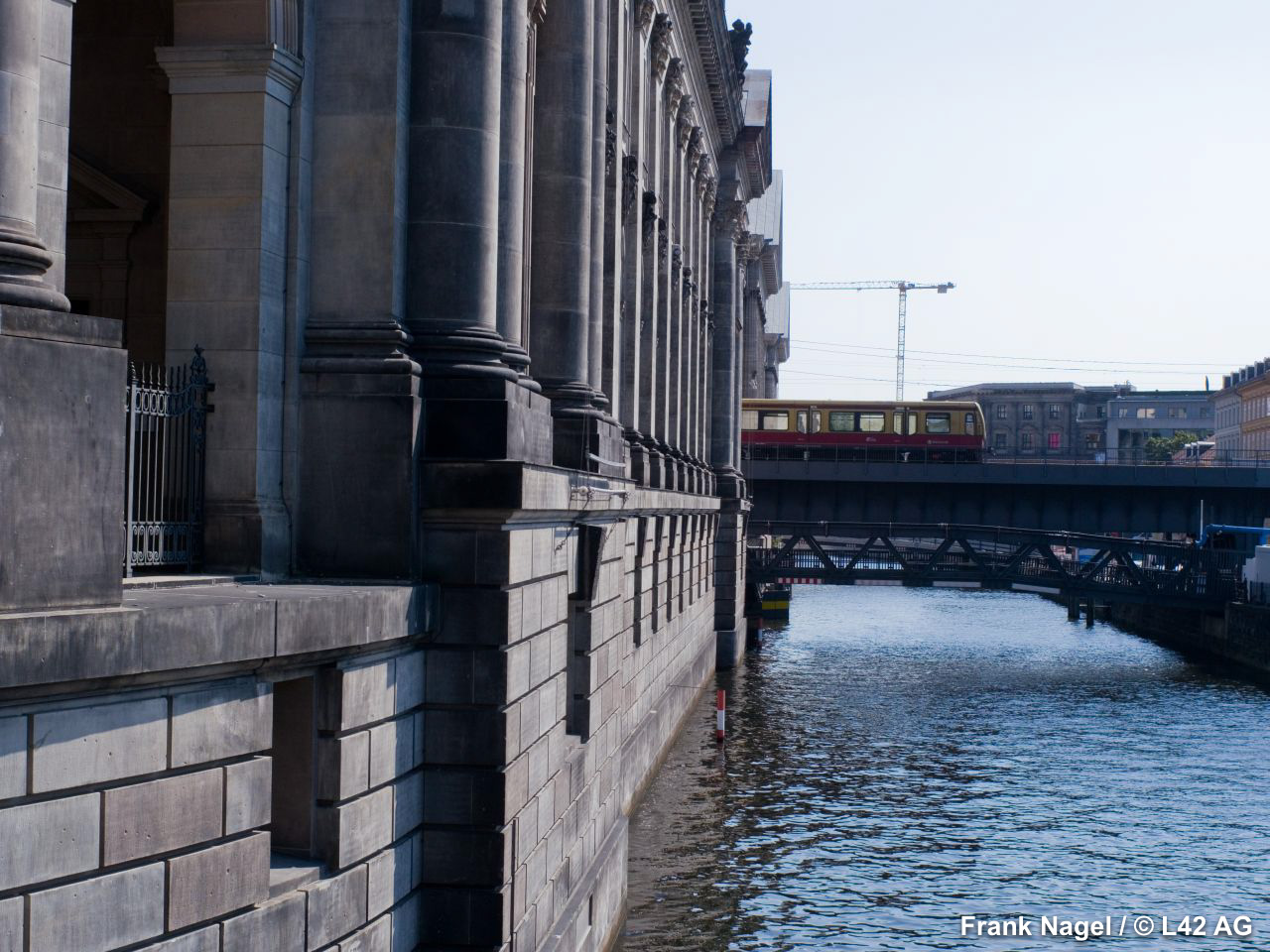
Horse-drawn carriages could still be found in Berlin at the beginning of 1920 but, little by little, they too began to disappear and Berliners began to move about on the rails. In fact, the very structure of the German capital itself has been shaped by the rail system: the network map speaks for itself. Road transportation is one thing, but rail transportation – with its odor of steel and burned rubber, its smudges, its whistles, the screech of steel on steel, its vibrations and wobbling, its blasts of air entering and exiting a tunnel, its light and dark, its three tones announcing the opening and closing of the doors – is indeed another.
You can travel across Berlin’s rails until you fall into a stupor (all night too) for only 7 euros, which is exactly as much as a day-ticket for the AB zones of the BVG, the Berliner Verkehrsbetriebe Gesellschaft, Berlin’s public transport authority, costs. If, however, you still haven’t seen everything by the end of the day, the following one you can just buy a new ticket. The BVG (pronounced bay-fow-gay) was founded on January 1, 1938, and divided into East Berlin BVG and West Berlin BVG on August 1, 1949, only to be reunited once again on January 1, 1992. And strange as it may sound, sometimes it seems more real than Berlin itself. The BVG manages all of Berlin’s public transportation; in other words, the buses, trams, subway and, in an agreement with the Deutsche Bahn (the German national railway), the urban stretches of long-distance trains. The train is truly Berlin’s best friend. After their first babblings and “mamas” and “papas”, when they’re in the mood for something adventurous young children immediately begin to sound out the word Bahn.
The metropolitan train network of the capital is divided into the S-Bahn, the abbreviation for the Stadtschnellbahn or Fast Urban Rail, which almost always runs through the city on stretches of track parallel to those of the Deutsche Bahn, and the U-Bahn or Untergrundbahn, which runs primarily, as you may have guessed, underground.
The S-Bahn network is made up of 15 lines, which crisscross all the central parts of the city as well as its outlying areas and suburbs. Of these lines there are also two circular ones known as the Ringbahn. The U-Bahn for its part is made up of 10 lines, but these do not run exclusively through the earth’s entrails. On the contrary, they often spring right up out of the ground and offer the commuter spectacular visions of the city, especially when they travel along the elevated rails. In the same way, the S-Bahn occasionally sinks down below ground and plays at being the U-Bahn. Essentially, we can distinguish between the two by their color alone: the U-Bahn is always yellow, and the S-Bahn is always beige and red.
The trams, or Straßenbahnen, however, only move above ground and since October 2, 1967, have been an exclusive part of the typical landscape of East Berlin. They are all painted a lively yellow color and shimmy throughout the city with a dance all their own. The only part of East Berlin where the trams didn’t stop during the time of the German Democratic Republic was Alexanderplatz, which was reserved exclusively for parades. Since December 18, 1998, however, the trams have been back there too.
At the time of the Wall, U-Bahn lines 1 and 2 were interrupted between the east and west while the U6 and the U8 no longer travelled through the east at all. These two lines, however, were also reinstated on July 1, 1990.
The history of Berlin’s railways is one of the most practical ways of telling the incredible story of this most unique of cities. During the time of the Two Berlins inconceivable things happened. The rails were literally cut, and some stations were even closed. These latter were known as “Ghost Stations,” for the trains simply did not stop. It was established, for example, that the Wollankstraße station, though technically in East Berlin, was under West Berlin’s jurisdiction and therefore could not be used by citizens of the GDR. In 1962 they even discovered an escape tunnel there among the rails…
Today we talk only about Berlin though we know full well that at one time Germany was divided and low-cost flights did not exist. The most common way to arrive in Berlin was by train. These long-distance trains to and from Berlin were officially called Interzonenzüge (Interzone Trains) and popularly known as Transit. Arriving in the East on a transit train from the West was like entering into another world, a frightening, militarily occupied world. The Hamburg-Berlin train, for example, would stop at the border and, as Norbert Weise recalls, a shrill voice from a loudspeaker would bark forth: “Schwanheide, hier ist Schwanheide! Werte Reisende, wir begrüßen Sie in der Deutschen Demokratischen Republik! Alle Reisende, die nicht nach Berlin fahren, werden aufgefordert, sofort auszusteigen, da dieser Zug bis Berlin nicht hält! Ich wiederhole! Alle Reisende, die nicht nach Berlin fahren, werden aufgefordert, sofort auszusteigen, da dieser Zug bis Berlin nicht hält!” Which means: “Schwanheide, we are in Schwanheide! Dear passengers, we welcome you to the German Democratic Republic! All passengers who are not travelling on to Berlin are asked to exit the train immediately, for this train will not stop again until reaching Berlin! I repeat! All passengers who are not travelling on to Berlin are asked to exit the train immediately, for it will not stop again until reaching Berlin!” The border police would enter the train, the entire rail staff would be changed, the train’s locomotive was changed (which in the GDR was often still a steam engine), the conductors came by with little trays attached to their necks as if they were selling popcorn; instead, they were used to control people’s passports and stamp them. The loudspeaker shot forth: Zug frei zur Kontrolle! A typical contradiction of terms employed by the regime which meant: “train free to be controlled.” Free in which sense? In the sense that the trains were stopped and the police’s German shepherds could get under them to try and sniff out stowaways and illegal merchandise between the train and the tracks. Bags were looked through, books and notebooks confiscated or censored. Naturally, taking photographs was highly illegal and so these moments are recorded only in memory and in the stories of those who travelled onboard the Transit. If you happened to arrive at night, floodlights were pointed at the trains to mimic daylight, but with a strange diffuse and blurry effect, one typical of the lights of the GDR.
One theme that shall accompany us like a red thread throughout this itinerary along the iron paths of Berlin is that of the crowd. People are always present on the tracks, even when seemingly absent. And you notice both absence and presence here more intensely than anywhere else. For there would be no railway system at all, you could say, without people.
When the first train departed from Potsdamer Platz headed for Potsdam in 1838 all the city was there to wish it well. When the first electric locomotive came out of the Borsig factory on August 21, 1858, close to 30,000 curious souls were waiting to see it at the factory gates. Where today you find the new and beautiful Hauptbahnhof there was once the Lehrter Bahnhof, which had seen the arrival and departure of princes, monarchs, dictators, infantrymen, and sailors, and always in the company of adoring crowds. Many people gathered on the rails of Bornholmer Straße the night of November 9, 1989, to help bring about the fall of the Wall and, with it, the movement of history. And even closer to us today, on July 29 and August 13, 2005, a number of people gathered together to help lower two giant, prefab iron structures from a height of 70 meters (229 feet) and a 90° angle to a horizontal position, like a draw bridge, which were to cover the Hauptbahnhof. The two enormous structures had been built separately so as not to interrupt rail traffic and were to be put into place on a weekend so as not to disturb commuters. And nevertheless the people, both commuters and non, came together on those two weekends precisely in order to watch.
There are those tracks that have a great effect on us whether we know the story, whether we only imagine we do, or whether these parallel lines running away from us make us dream of going somewhere else, of following a path ourselves in some way or another. Indeed, many a post-war child played between the bombed out tracks of Berlin, dreaming of a thousand ways to leave.
Wherever we may find ourselves in the city we can always see a train emerging somewhere from out of the background: the yellow U-Bahn, S-Bahn’s beige and red, the two-tiered regional trains. And then there are the Deutsche Bahn’s long-distance trains with their DB painted on the side, but there are other countries’ trains too not to mention the trams that always seem to appear quite suddenly from around a corner.
One of the most magnificent places you can see trains pass by is the bridge next to the Bode Museum. While you are quietly admiring the mosaic from the apse of the church of San Michele in Africisco in Ravenna with its Christ in typical Byzantine frontal position, a symbol of divine wholeness, who is holding a copy of the Gospel which says: “Anyone who has seen me, has seen the Father too,” and is surrounded by the archangels Michael and Gabriel and the seven cherubim with their trumpets, while you are standing there enraptured and imagining the joyous sounds of those trumpets in Paradise a piercing whistle tears through your vision and, petrified, you turn to see a blur of cars passing behind the windowpanes, one after the other. As invaluable and fascinating the Bode Museum may be, the trains’ whistling and clattering right there at the level of the windows is likely what shall remain in our memory.
That which seems so simple and obvious to us today once was only the dream of various visionaries, of extraordinary human beings who irreversibly brought us from the ancient world into that of modernity. Even if there are many areas where humankind’s genius brought forth astonishing fruits, it is the myth of the train, of rapid movement in almost any direction, which remains one of the achievements that still enthralls us the most today.
If we look at all of the stations of Berlin – from the tiny Nikolassee close to Wannsee, constructed in 1902, to the beautiful Art Noveau-style ones of the subway, to today’s über-modern structures of glass and steel – we understand that these buildings are not only functional, but conceptual, and as such are the truly beloved symbols of modern temples of a real cult of mobility. There are simple and essential stations, but there are also charming and downright luxurious stations too. The large iron and bolted pillars in some of the U-Bahn stations are, for example, lightened by elegant Ionic capitals: at Wittenbergplatz these are a dark green; at Alexanderplatz chestnut; at Senefelder Platz blue. In some stations, like Viktoria-Luise Platz, there are even still high-backed wooden benches where passengers wait for their respective trains literally back to back, just like in the old trains of the Wild West. The U3 is a mixture of styles, history, and colors.
Traversing the tracks of the capital is always much more than simply arriving at a destination. A trip is always a trip through space within a certain physical time, but also a trip through a past historical dimension, or one that has not yet come into being, or simply our imaginations.
Translated by Alexander Booth

